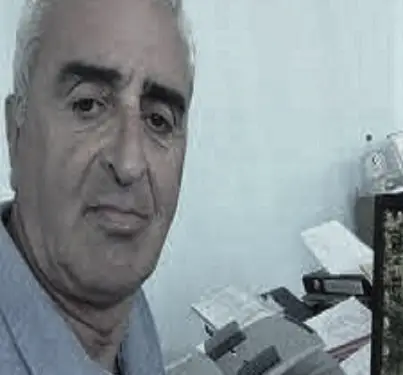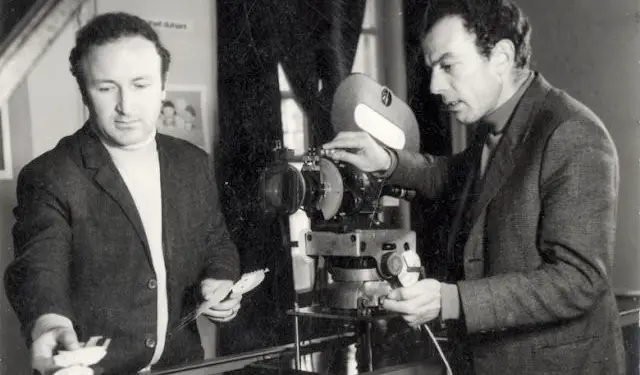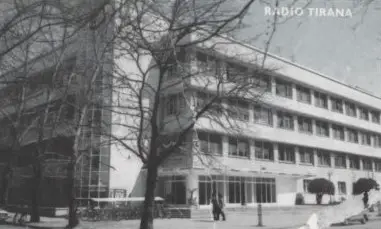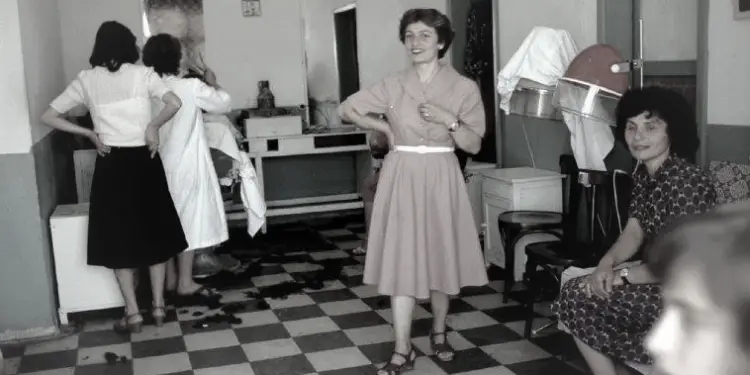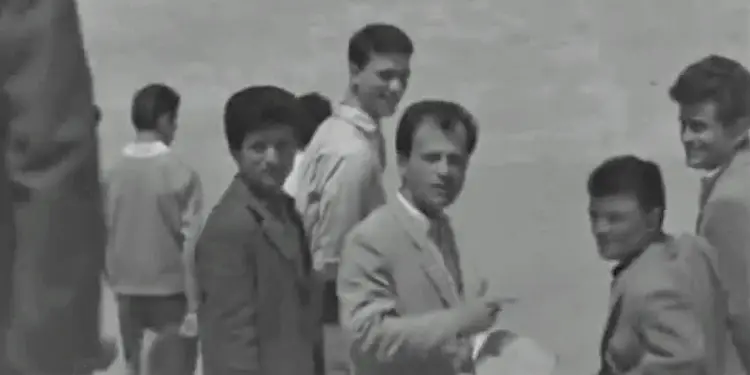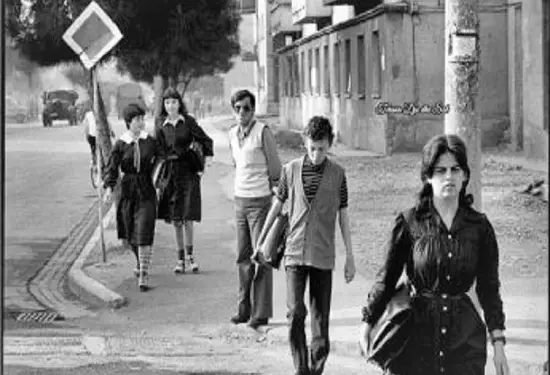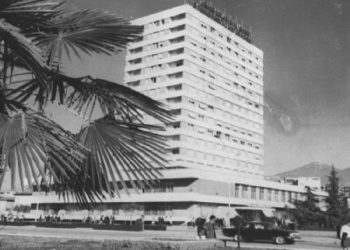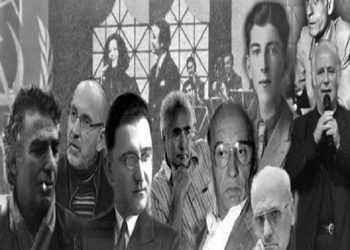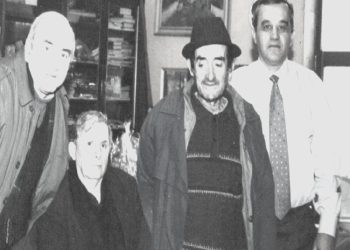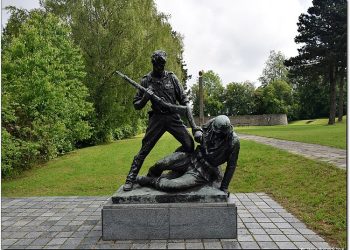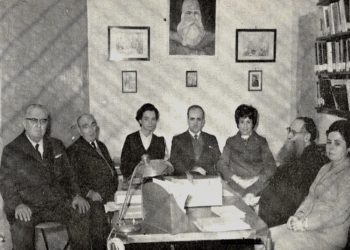From Uvil Zajmi
Memorie.al / Staying at “Flora” Bar-Café and frequenting Durrës Street came after the 70s, when the political situation in Albania, especially at the beginning of 1973, got worse. Leaving “Broduej” and visiting that area in the center of Tirana in the evening, with the dessert landmark “Florën”, came spontaneously to become a necessity over time. First, from the residents of the surrounding buildings, to continue with the high school students of “Sami Frashëri”, “Qemal Stafa” of the Polytechnic, who crossed paths at lunch, but also in the evening, with friendship groups on both sides of “Flora” where everything was discussed, including any sports, artistic information, a bit of politics related to life and events of the day, week in the country and abroad.
“FLORA”, the modern bar of the time…!
“Flora” pastry shop, a café-pastry shop with two main entrances in the front-eastern part, became preferred as a bar with modern elements after 1965 by students who had graduated abroad, mainly in the east. Its decoration was entrusted to the décor of NTSHUS Tirana and two well-known painters Qamil Prizreni and Ymer Koçi. Everything in walnut wood, especially the counter produced in the “Misto Mame” wood plant. The chairs were of a special style, chaise longue type, very comfortable.
The bar was painted with hydromats of different colors on all its sides, placing small wooden ceilings as décor and some “still nature” paintings. In the evening it was a great pleasure to stay there, even you couldn’t find a seat. In winter, the indoor environment was used, while in the summer, the outdoor environment was also used. Initially, there was also a petrol distributor where the “Viberti” or “SATA” bus (that’s how the Italian brand buses were known by the people) that went to Laprakë took a turn.
Soup, parfait and poncho, favorites
As the first attendees were students who had just returned from abroad and at “Flora” they found or improvised the western atmosphere left behind, mainly in the evening, the bar was full. He didn’t speak loudly, he smoked “Diamant” or “Luks” cigarettes, years later “DS” (Durrës Special). Ice cream in cup-shaped xingato glasses was a tradition, but “Flora” is remembered for the cakes, English soups, oranges, compekaya and parfaits, which cost from 25 ALL.
The favorite was orange poncho, a product of the “Ali Kelmendi” Food Plant in Tirana, a drink that has just been released, sweet and strong. Then ferneti, cognac, vermouth and curlicue, which was a mix of ferneti and poncho and which had an explosion as a special drink for the time and was preferred by all, boys and girls, pupils and students who left class to meet in love where Ganimeti, Lola, some of the bar’s model waitresses served.
Mehmet Shehu’s order, with a fine for sitting on the curbs
The young people of those years no doubt remember sitting in the evenings at the curbs of shop windows, when they were closed on both sides of “Flora”, divided into groups. But as time passed, it became difficult to sit there, as the police no longer allowed such groups. Even, by an order of Mehmet Shehu, they were painted with oil and grease to prevent the boys from sitting on those concrete strips.
The law enforcement forces of the “Mine Peza” region, who were checking, had made friends with the boys of the curbs and every time they passed, they would “stand up and then sit down” as a sign of understanding when they were patrolling. The climax was reached when a fine of up to 100 Lek was imposed for people who frequented the curbs.
From Gim Krajka’s song, to feature films…!
With text by Xhevahir Spahi, the well-known composer Agim Krajka, referring to the bar’s attendance, appeared at the 11th National Radio-Television Song Festival, with the song “Cafe Flora”, which was sung by the 17-year-old Born Theodhori. Although it charted at number two and gained traction, it was dropped from radio after the Festival hit. Also, three films were shot on that road: “Bullet on the Emperor”, which is related to the assassination of Vasil Laçi against Viktor Emanuel III, role played by actor Kastriot Çaushi.
Even a fragment of the film “Debatik”, the scene where Coli is killed, with the actors Besim Lëvonja and Sulejman Pitarka, was shot a few meters deep, in Likve square. Then the dramatic film “Death of the Horse”, starring the well-known actors Timo Flloko and Raimonda Bulku, with the scene of exile performed behind the palace on “Flora”.
“Love story” and artistic inspiration
In a short time, “Flora” was transformed into the environment of love, acquaintances, engagements, exchange of rings, rings, but also of artistic inspiration for young artists. “Together with Kiço Blushi, Rikard Ljarej, Leka Bungo and Sherri Mita, we have been systematic customers of ‘Flora’. We sat at a table at the end of the bar and inspired by the style and history of writers, mainly from countries like France and Italy, we wrote artistic creations”, recalls Bujar Kapexhiu.
“We tried to imitate, even there the comedy ‘Keshilli i Ndrikullave’ was created by Sheri Mita, based on the love of Leka Bungo with his wife, an ambassador’s daughter with the apartment in front of ‘Flora’, who had four aunts, who went out on the balcony they controlled Leka’s movements when he entered ‘Flora’.
Such is the love of the daughter of Mantho Bala, the former Deputy Minister of Education, who lived above ‘Flora’, with the footballer of ’17 November’, Tit Nurishmi. While the painter Ali Oseku, made sketches of girls, boys, friends, who came there and then gave them the drawing”, concludes Kapexhiu. Just for a glance, meeting, provocation, or waiting for a girl, the boys in love drank up to ten coffees a day at “Flora”.
To “Pig” with the clandestine lotto-sport
That’s how they called it “Pig”, a not at all charming name, which was actually a “breakfast room” or “breakfast room” in front of the Cuban Embassy. A stand-up prepaid self-service, paying at the till, where Kimetja served as cashier and Nexhi with her. Inside, on the left side of the entrance, there was also a kinkaleri, where it was said that the seller had a double “mission”.
It was called “Pig”, or “Pig”, since that was the meat that was served, but also because of the extended hours. Until late in the summer and winter, especially when it rained, all the groups gathered under the shelter of the “Pig”. Especially on Saturday and Sunday the flow was very large. The “pig” also turned into an important point of information that was received and distributed about music, politics (not much), sports, the pink chronicle, infinity of capital gossip.
It is precisely at “Derri” that it has its origins and the clandestine lotto-sport was played for the first time, although that sport existed in Albania until the 60s. After it was banned, there were sporadic attempts to activate it by individuals, initially with small amounts, then the number increased and reached gigantic proportions in participation and financially.
Hysenaj, one of its organizers, says: “Very quickly this mechanism with circumstantial means began in secret, in close friendship groups. Every weekend, handball was played for the A series, and in the years that followed, there was a large participation from pupils and students, workers, visitors to ‘Flora’, from other areas of Tirana, and even from the districts.
I remember that even the policemen who passed by, secretly called the games in our clandestine lotto-sport. The peak was in the years 1975-’85, when some of the creators were punished with imprisonment”, he says.
Alqi Boshnjaku, Dor Keko and Perlat Voshtina
You cannot talk about Durrës Street, the stay at “Flora”, without remembering at least some characters who are not alive today, among them Alqi Boshnjakun, Dor Keko and Perlat Voshtina. One poet and writer, the other composer and Voshtina, engineer and volleyball player.
They lived very close to each other and all three were well known for their passion for sports. They frequented that street, especially in the evening in the yard of “Flora”, sitting on its curbs. All three unfortunately passed away at a young age.
Well-known families, from Progri to Kodra and Kubati
On that street in front of the court lived Ali Progri, the legendary director of the Polytechnic with his family, a kind, noble and very humane man. In the next palace, Gani Kodra, another person known for those years. He and his family, sons Gencin and Tanin, nephews and nieces L. Kodra and the unforgettable Petrit Kodra, journalist at ATSH, the first to supply sports information to the “Derrit” enthusiasts.
Then Ali Kubati, this one also continuing to the palace at the first intersection. Very popular, the Cubans had a large circle of friends. The two sisters of the hero Qemal Stafa were permanent residents of this street; they always went out for a walk together. The Russian woman, Galina, lived in the building in front of the Officers’ Palace, with her daughter Sonja and Zana Karagjozi, a sportswoman of “Dinamo”, also Russian from her mother’s side, as well as Ad Shehu. The family of the philanthropist Dine Hoxha lived nearby, with grandchildren Skënder, Dine, and Bujar, next to the palace where the cultured woman and admirer of Italian music, Xhilda, lived with her daughter Jozita.
Lelio Lutazzi’s “Hit Parade” and “Radio Praga”, a popular show every day at lunch, requested by Italian immigrants, could be heard softly from the window of her apartment.
The “Blue” palace of the generals
Built during the Italian era, at the first intersection, the beautiful blue brick palace is a building that has stood the test of time and is today known as the Merlik Palace. For many years after the war, the Customs House was on its first floor, later a butcher, and then a bookstore. From Lieutenant General Abaz Fejzo, the soldier who appeared in front of the tribune at the start of every parade, Maliq Sadushi, Todi Shyti, Kristo Themelko, to Sabri Pilkati, all major personalities of the time have lived there. Later, in a villa in front of the Yugoslav Embassy, the Rear Admiral of the Navy, Abdi Mati, was with his children, the painter Zamir, his daughter Teuta and Ilir Mati.
The beautiful modern girls who gave it its name
The “Rruga e Durres” was also notable for beautiful girls. The street was decorated even more by N. Xhai, T. Buxheli, the Progri sisters, three friends E. Gjylbegu, A. Omari, L. Siliqi, the twins Veronika and Ludmilla, who also played as actresses in the movie “Lady from the City”.
Then the beautiful Lida, Shpresa the dancer of the Ensemble, J. Nase, V. Biba, leaving G. Herr for the end, since when she came out of the tunnel to the ‘Durres Street’, everyone was holding their breath to see her for her beauty . Even the modern couple who stood out for their elegance in clothing, A. Rasku and M. Učin, attracted attention.
Historical doctors and teachers
There are many: From Dr. Ilir Gjylbegu, Dr. Anila Gode, Dr. Emil Cimbi Dr. Selaudin Bekteshi, Dr. Theollosis. Dr. Ilir Ohri, Dr. Jorgji Koja, Dr. Gazmend Velçani, Dr. Ferdi Konomi, Dr. Petrit Gaçe, Dr. Nikola Shurbani, Dr. E. Germany, Dr. Ylli Popa, Dr. F. Konini with his Austrian wife Paola.
Then the teachers Mr. Xhajanka of literature, Sar Çakmaxhian of chemistry, A. Karagjozi and teacher Tana of English, L. Naçe of mathematics at A. Rustemi, of physical culture M. Tukseferi, prof. Gjergj Canco, Llazar Xhajanka, etc.
Actors, painters and sculptors, “Via del Artisti”
It would be more than normal for it to be known as the “Street of Artists”, as it has been. The actors Sulejma Pitarka, Besa Imami, Kadri Roshi, Luiza Varfi, Margarita e Shkëlqim Xhepa Qenan Toro, Andrea Pano, A. Imami, A. Kura, Drita e Hysen Pelingu, Violeta Manushi, Piro Milkani, Viktor Gjika, the Sallaku family lived there. , Vitore and Skënder, that of filmmakers Xhanfise and Endri Keko, VAT operators: Arben Çeku and Fred Leli, brothers Pandi and Bled Laço, director Aartan Minarolli, conductor Rifat Teqja, Thimi Nika, family Zela, Vaçe and Hysni, musicologist Ramadan Sokoli, the composers Nikoll Zoraqi, Pjetër Gaci with the Russian woman Tamara; tenor Gjoni Athanas with Sakinena, his ballerina wife; the Čako family with Gaqo and Luiza Papa, the family of musician Topi, oboist Viktor Shiroka; singers Xhavit Xhepa, Fitnete Rexha, pianist Bebi Kristidhi, musicologist E. Dheri; sculptors Odhise Paskali and Dhimitër Çani, painters Kel Kodheli, Foto Stamo, etc.
Ali Zotria, an engineer-chemist, also lived on the sixth floor above “Flora”. He was convicted after he married Jezmina, the Czech woman, with whom he left after the 1990s and lives in the Czech Republic. In an apartment on the fourth floor, in the building behind the Cuban Embassy, lived an engineer-chemist, Agim Shehu, who had brought a television from Russia, on which everyone gathered to watch.
Writers and researchers
The family of the scientist Petro Zheji with Vera and Artur, the writers Nasho Jorgaqi, Andrea Varfi, Sotir Papuli, Fatmir Gjata, Qamil Buxheli, Dhimitër Xhuvani, Andrea Varfi, Teodor Laço, Llazar Siliqi, Vangjeli and Spiro Çomorra, translators also lived on Durrës Street. the well-known Sami Leka and Niko Gjini, journalist Kastriot Ahmati, photographer of the National Academy of Sciences Pipi Naçe, professors and academics: Alfred Uçi, Aaleks Buda, Bedri Dedja, Shaban Demiraj, Fatos and Luan Omari, Kol Paparisto, researchers Spiro Xhai and Sotir Kuneshka , Mane Nishova, the man of the hour in VAT, Petrit Leka, ambassadors Piro Koçi and Fatmir Kumbaro, construction engineer H. Rama, Maqo Bleta, as well as Lluka, the boy with glasses who called him “the philosopher”.
Her “play boy”.
That path would not have made sense without some of its mythical characters. Gen Nika, the modern boy, problematic for the system, always one step ahead in fashion, taste and passion. Gen Dalta and Kokushta were very special, charming, and vital.
Ylli Koçi, also tall, elegant, dressed beautifully, when he went out he attracted attention together with his brother Fati and his two sisters. Then Kirov Andoni, the absolute and authentic protagonist of “Durres Street”, guitarist, singer, like two drops of water with the Frenchman Charl Aznavour, favorite in the evenings of high schools, mainly of “Qemal Stafa”.
Kirov also built a small personal swimming pool on the terrace of the Officers’ Palace where he lived, which became a problem for the neighborhood. While the stay at “Flora” is connected with boys, without whom her story cannot be written. By B. Çaushi (Xuxi), G. Estrefi, I. Elini, T. Gjoka, A. Ruço, K. Hysenaj, E. Deliallisi, Perikli Dhales, Skënder Hyka, B. Hyka A. Nurishmi, Gog Halili, B. Tabaku, Sh. Ndroqi, the brothers Besnik and Agim Hado, etc.
Very enigmatic was Mihal Kosova, who had studied Literature in Athens, but because of his biography, he worked as a painter. In the morning he served in houses and apartments by painting, in the evening at “Flora” he appeared differently, well dressed and with a good mood.
“QEMAL-STAFAS” group of “Besnik” and “SAMI FRASHĖRI”
“Flora” has been in tune with several individuals and groups: the brothers Mir and Ilir Dashin, Shan Vorfin, Tor Ickën, Sh. Xhepën, A. Bajko, Dor Keko, A. Sejko, F. Hanxhak, P. Becin, A. Dumë, Bes Vilë, Z. Birçe, B. Gajtanin, Jan Kasneci, S. Vukaj, etc., as well as the Zotria brothers, Gux and Bujar Sevrani, Rrok and N. Dionisi, Geg and Lek Kodheli.
Then the three friends A. Obdari, A. Kubati, L. Tasellari, the three sympathizers T. Anamali, B. Shehu and P. Seiti, the musketeers Dhimitër, Dëfrim and Genc, residents of the “Pension Hotel” building, with the ever-present Ruke and “Stive Rivesin” – Niku, the first Albanian tattoo artist.
Another group was the one with students of “Sami Frashëri”: A. Sallaku, Mir Prifti, M. Ostreni, M. Barbullushi, M. Çoçoli, A. Shehi, B. Lame, T. Kosta, K. Andoni, B. Plaku , Tit Nallbani, H. Topi, K. Paçrami, B. Mema, Nik Alimehmeti, F. Çoçoli, A. Alimehmeti. etc., without forgetting Ilir Demaliaj, the famous “Eye” resident of the palace above the Ark of Savings at the first intersection. All the “loyal” boys of “Flora” and “Derri”, “Polikumas”, “Qemalstafas”, and “Sami”, you could find them there every evening, never missing.
Love with high school students after “Figal”
It was a street frequented by “Shkëndi” football players, who after school and training, you could find them gathered at “Figali”, the small knick-knack at the third intersection, which was named after the seller. Sul Starova, Dash Bajaziti, Arjan Bakiri, A. Toqi, Vasil Bifsha, Il Metani, Ilir Luarasi, or K. Andoni, N. Topi, G. Maluçi, G. Shahu, Jar Battisti were all waiting for the high school girls to come out crossing, meeting after “Figal”.
A lot of love and acquaintances have their origin there; even some of the footballers of “Shkëndi” have married precisely the girls of “Qemal Stafa” of the Polytechnic.
Sportsmen
From football player Aristidh Parapani, champion of the Balkans in ’46, to the family of F. and Mustafa Çelkupa, athletes Shaban Lundra, Dhimitër Stratobërdha, Liljana Karanxha, Dh. Djaku, I. Gusho, A. Papuli, Viron Bezhani (former President of KOKSH), football players Riza Icka, B. Keno, S. Sinani, A. Nurishmi, Gud Tafaj, the sports family Tomorri with Ylli, Luan and Genci ; chess player Ilir Karkanaqe; basketball players S. Boshnjaku, V. Dalta, Sandër Dheri, A. Demiri, volleyball players S. Vokopola, R. Gjerazi, S. Hanxhak, boxer Ahmet Golemi, B. Isaku, wrestling champion Ndriçim Spahiu, Nuzi, with a beautiful body, are some who have left their mark on Durrës Street. Even the Dormitory (after the ‘Pensioni’ Hotel), first with the girls of the High School and then for the athletes of the ILKF “Vojo Kushi”, have given life to the street.
Not forgetting the matches at the Sports Palace: the three blocks with police who checked tickets when the flow was great, then the end of the meetings when fans, friends and colleagues waited for the athletes and accompanied them back together along Durrës Street, on the sidewalk on the right.
What do you have left today…?
It is not a gastronomy, nor Gazhelev’s store, nor “Perfumeria”, nor “Derri”, nor “Malev”, nor Trikotazhi. There is no trace of “Demneri”, the bicycle shop, nor the court, nor the barber, nor the custom-made shoes, nor the “Pensioni” hotel.
The main one, “Flora”, has been reduced to a small bar called “Café-Flora”. Meanwhile, many characters do not live and others who have moved, while those who gave life are family members.
That very popular corridor no longer has the attendance of the 70s, as it has turned into a normal street, without delegations and people waiting for it with flowers, it lacks the noise, the vitality that gave it excitement and splendor in the years of its peak. Memorie.al




